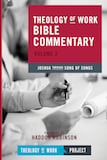Financial Accountability in the Temple (2 Kings 12:1-12)
Bible Commentary / Produced by TOW Project
One example of the degeneration of the kingdom ironically serves to bring to light a model of good financial practice. Like virtually all of the kingdom’s leaders, the priests had become corrupt. Instead of using worshippers’ donations to maintain the Temple, they pilfered the money and divided it among themselves. Under the direction of Jehoash, one of the few kings “who did what was right in the sight of the Lord” (2 Kings 12:2), the priests devised an effective accounting system. A locked chest with a small hole in the top was installed in the Temple to receive the donations. When it got full, the high priest and the king’s secretary would open the chest together, count the money, and contract with carpenters, builders, masons, and stonecutters to make repairs. This ensured that the money was used for its proper purpose.
The same system is still in use today, for example when the cash deposited in automatic teller machines is counted. The principle that even trusted individuals must be subject to verification and accountability is the foundation of good management. Whenever a person in power—especially the power of handling finances—tries to avoid verification, the organization is in danger. Because Kings includes this episode, we know that God values the work of bank tellers, accountants, auditors, bank regulators, armored car drivers, computer security workers, and others who protect the integrity of finance. It also urges all kinds of leaders to take the lead in setting a personal example of public accountability by inviting others to verify their work.
Related Content
Popular Content
Popular Content
Table of Contents
- Samuel, Kings & Chronicles and Work
- Introduction to Samuel, Kings and Chronicles
-
From Tribal Confederation to Monarchy: 1 Samuel
- The Calling of Samuel (1 Samuel 1-3)
- The Perils of Treating God Like a Good Luck Charm (1 Samuel 4)
- The Opportunities That Arise From Working Faithfully (1 Samuel 5-7)
- Samuel’s Sons Disappoint (1 Samuel 8:1-3)
- The Israelites Ask For a King (1 Samuel 8:4-22)
- The Task of Choosing a King (1 Samuel 9-16)
- David's Rise to Power (1 Samuel 17-30)
-
The Golden Age of the Monarchy: 2 Samuel 1-24, 1 Kings 1-11, 1 Chronicles 13, 21-25
-
David's Successes and Failures as King (2 Samuel 1-24)
- David’s Rape of Bathsheba and Murder of Uriah (2 Samuel 11-12)
- David’s Dysfunctional Handling of Family Conflict Leads to Civil War (2 Samuel 13-19)
- David Learns He Needs God’s Guidance How to Do His Work (1 Chronicles 13)
- David’s Disobedience to God Causes a National Pestilence (1 Chronicles 21:1-17)
- David’s Patronage of the Musical Arts (1 Chronicles 25)
- Assessing David’s Reign (1 Kings)
- David Prepares Solomon to Succeed Him as King (1 Kings 1; 1 Chronicles 22)
- Solomon Succeeds David as King (1 Kings 1-11)
- Assessing Solomon's Golden Age (1 Kings)
-
David's Successes and Failures as King (2 Samuel 1-24)
-
From Failed Monarchies to Exile (1 Kings 11 - 2 Kings 25; 2 Chronicles 10-36)
- Obadiah Saves a Hundred People by Working Within a Corrupt System (1 Kings 18)
- Ahab and Jezebel Murder Naboth to Get His Property (1 Kings 21)
- The Prophet Elisha’s Attention to Ordinary Work (2 Kings 2-6)
- The Southern Kingdom's March Toward Exile (1 Kings 11:41 - 2 Kings 25:26; 2 Chronicles 16 - 36)
- Rehoboam’s Failure to Tell Good Advice From Bad (2 Chronicles 10:1-19)
- Conclusions from Samuel, Kings, and Chronicles
Related Content
Donate
Bookstore

(Volume 2: Joshua-Song of Songs) If you like reading the Theology of Work Bible Commentary free online, you might enjoy it in print!—Business, education, law, service industries, medicine, government - wherever you work, in whatever capacity, the Scriptures have something to say about it.

The Theology of Work Bible Commentary is an in-depth Bible study tool put together by a group of biblical scholars, pastors, and workplace Christians to help you discover what the whole Bible--from Genesis to Revelation--says about work. Business, education, law, service industries, medicine, government--wherever you work, in whatever capacity, the Scriptures have something to say about it. This edition is a one-volume hardcover version.
Bible
Topics
Copyright
Contributors: Jill Baker, Brian Housman and Alice Mathews
Adopted by the Theology of Work Project Board June 2, 2014.
Theology of Work Project Online Materials by Theology of Work Project, Inc. is licensed under a Creative Commons Attribution-NonCommercial 4.0 International License. Based on a work at www.theologyofwork.org
You are free to share (to copy, distribute and transmit the work), and remix (to adapt the work) for non-commercial use only, under the condition that you must attribute the work to the Theology of Work Project, Inc., but not in any way that suggests that it endorses you or your use of the work.
© 2014 by the Theology of Work Project, Inc.
Unless otherwise noted, the Scripture quotations contained herein are from the New Revised Standard Version Bible, Copyright © 1989, Division of Christian Education of the National Council of the Churches of Christ in the U.S.A., and are used by permission. All rights reserved.










